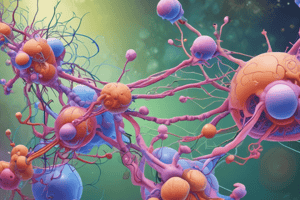Podcast
Questions and Answers
What is the main mechanism by which a drug or hormone signal is transmitted into the cell via GPCRs?
What is the main mechanism by which a drug or hormone signal is transmitted into the cell via GPCRs?
G Protein
How many transmembrane helices do all GPCRs have in common?
How many transmembrane helices do all GPCRs have in common?
7
What distinguishes Family A GPCRs from Family B GPCRs in terms of their structure?
What distinguishes Family A GPCRs from Family B GPCRs in terms of their structure?
Family A do not typically have an extracellular domain, while Family B GPCRs do.
What is the study of how individual genetic differences can influence how drugs work through receptors called?
What is the study of how individual genetic differences can influence how drugs work through receptors called?
What must be done to study GPCRs, considering their microenvironment and structure?
What must be done to study GPCRs, considering their microenvironment and structure?
Where is the orthosteric binding pocket located in the Beta 2 Adrenergic Receptor?
Where is the orthosteric binding pocket located in the Beta 2 Adrenergic Receptor?
What is the main role of Beta 2 Adrenergic receptors in heart failure?
What is the main role of Beta 2 Adrenergic receptors in heart failure?
How does Propranolol act on Beta 2 Adrenergic receptors?
How does Propranolol act on Beta 2 Adrenergic receptors?
Explain the concept of GPCR cross reactivity.
Explain the concept of GPCR cross reactivity.
What is drug repositioning/repurposing in the context of GPCRs?
What is drug repositioning/repurposing in the context of GPCRs?
Describe the role of glycosylation in proteins.
Describe the role of glycosylation in proteins.
What are the three subunits that make up a G protein?
What are the three subunits that make up a G protein?
What percentage of disease states concerning membrane proteins are accounted for by mutations in the conserved amino acids?
What percentage of disease states concerning membrane proteins are accounted for by mutations in the conserved amino acids?
What is the role of cholesterol in GPCR function?
What is the role of cholesterol in GPCR function?
How do mutations in a conserved Tryptophan affect GPCRs?
How do mutations in a conserved Tryptophan affect GPCRs?
Explain the concept of allosteric regulation in GPCRs.
Explain the concept of allosteric regulation in GPCRs.
Flashcards are hidden until you start studying
Study Notes
G Protein-Coupled Receptors (GPCRs)
- GPCRs are a collective term for membrane proteins that share a common mechanism of signaling
- They have a common structure, with 7 transmembrane helices
- Approximately 800 different GPCRs exist in humans, divided into classes (e.g., Family A and Family B)
- Family A GPCRs typically lack an extracellular domain, whereas Family B GPCRs have an extracellular domain
Function and Mechanism
- A drug or hormone binds to a GPCR, and the signal is transmitted into the cell via a G Protein
- The signal is transmitted through a mechanical conformational shape change in the receptor
- This allows recruitment of a G protein at the intracellular side, which is composed of 3 subunits (alpha, beta, and gamma)
Microenvironment and Post-Translational Modifications
- The microenvironment of GPCRs influences their function (e.g., lipids surrounding the receptor and interacting proteins)
- Glycosylation (addition of sugars) and disulfide bonds (between cysteine amino acids) are important for GPCR structure and function
Orthosteric Binding Site and Conformational Change
- The orthosteric binding site is the main binding site for the ligand, located in the transmembrane helix
- The binding of a ligand induces a conformational change, allowing recruitment of the G protein
Disease and Mutations
- Mutations to conserved amino acids in the center of the receptor account for 87% of disease states concerning membrane proteins
- Mutations can either stop signal transmission, increase sensitivity, or cause constitutive activity
Cholesterol Binding and Allosteric Regulation
- All GPCRs have a specific cholesterol binding site located on the external surface of the receptor
- Cholesterol binding is necessary for GPCR function; without it, receptors may activate spontaneously or not operate at all
- Allosteric regulation of GPCRs by cholesterol modulates the function of the orthosteric pocket
Studying That Suits You
Use AI to generate personalized quizzes and flashcards to suit your learning preferences.




